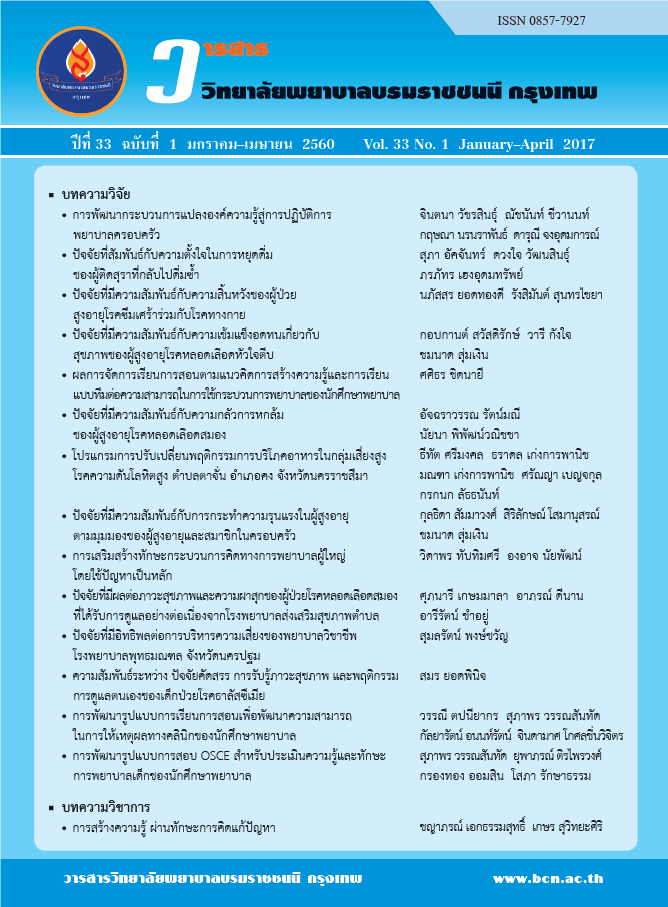ความสัมพันธ์ระหว่าง ปัจจัยคัดสรร การรับรู้ภาวะสุขภาพ และ พฤติกรรมการดูแลตนเองของเด็กป่วยโรคธาลัสซีเมีย THE RELATIONSHIP BETWEEN SELECTED FACTORS, HEALTH PERCEPTION, AND SELF-CARE BEHAVIORS OF THALASSEMIC’S CHILDREN
คำสำคัญ:
การรับรู้ภาวะสุขภาพ, พฤติกรรมการดูแลตนเอง, เด็กป่วยโรคธาลัสซีเมีย, health perception, self-care behavior, Thalassemic childrenบทคัดย่อ
บทคัดย่อ
การวิจัยเชิงพรรณนา (descriptive research) นี้ มีวัตถุประสงค์เพื่อศึกษา 1) การรับรู้ภาวะสุขภาพและพฤติกรรม การดูแลตนเองของเด็กป่วยโรคธาลัสซีเมีย 2) ความสัมพันธ์ระหว่างปัจจัยคัดสรรและพฤติกรรมการดูแลตนเอง และ 3) ความสัมพันธ์ระหว่างการรับรู้ภาวะสุขภาพและพฤติกรรมการดูแลตนเอง กลุ่มตัวอย่าง คือเด็กป่วยโรคธาลัสซีเมีย อายุ 9-12 ปี ชนิดพึ่งการให้เลือดที่มารับการตรวจรักษาที่คลินิกโรคเลือด สถาบันสุขภาพเด็กแห่งชาติมหาราชินี โรงพยาบาล ปทุมธานี โรงพยาบาลธรรมศาสตร์เฉลิมพระเกียรติ รวม 140 คน เก็บรวบรวมข้อมูลโดยแบบสอบถามการรับรู้ภาวะสุขภาพ ประยุกต์จากแบบสำรวจภาวะสุขภาพ และ พฤติกรรมสุขภาพเด็กทั่วโลกขององค์การอนามัยโลก และแบบสอบถาม พฤติกรรมการดูแลตนเอง พัฒนาจากทฤษฎีการดูแลตนเองของโอเร็ม วิเคราะห์ข้อมูลโดยใช้สถิติเชิงพรรณนา และ สัมประสิทธิ์สหสัมพันธ์ของเพียร์สัน และ ไคสแคว์ ผลการวิจัยพบว่า 1) กลุ่มตัวอย่างมีการรับรู้ภาวะสุขภาพอยู่ในระดับสูง (Mean = 66.45, S.D. = 0.90) 2) พฤติกรรม การดูแลตนเองในภาพรวมอยู่ในระดับสูง (Mean = 47.85, S.D. = 0.75) 3) ปัจจัยคัดสรร เพศ อายุ ระยะเวลาการเจ็บป่วย การได้รับการตัดม้าม การได้รับความรู้เกี่ยวกับโรคธาลัสซีเมีย การได้รับการให้เลือด มีความสัมพันธ์กับพฤติกรรมการดูแล ตนเองอย่างมีนัยสำคัญที่ระดับ.05 4) การรับรู้ภาวะสุขภาพโดยภาพรวมมีความสัมพันธ์ในระดับปานกลางกับพฤติกรรม การดูแลตนเองอย่างมีนัยสำคัญทางสถิติ (r = .77, p < .01) และ การรับรู้ภาวะสุขภาพด้านสังคม ด้านจิตใจ ด้านร่างกาย ด้านจิตวิญญาณ และด้านภาพลักษณ์ มีความสัมพันธ์ในระดับปานกลางกับพฤติกรรมการดูแลตนเองอย่างมีนัยสำคัญ ทางสถิติ (r = .74, .66, .62, .61, และ .55, p < .05, ตามลำดับ)
ข้อเสนอแนะจากการวิจัย บุคลากรสุขภาพควรส่งเสริมให้เด็กป่วยโรคธาลัสซีเมียได้รับความรู้และให้ได้รับรู้ภาวะ สุขภาพของตนเอง เพื่อให้เกิดพฤติกรรมการดูแลตนเองที่เหมาะสมต่อไป
Abstract
This descriptive research aimed to study 1) perception of health status and self-care behaviors of thalassemic children, 2) relationships between selected factors and self-care behaviors, and 3) relationship between perceived health status and self-care behaviors. A total of 140 transfusiondependent thalassemia patients aged 9 - 12 years and follow- up at hematology clinics at the Queen Sirikit National Institute of Child Health, Pathumthani Hospital, and Thammasat Chalerm Phra Kiat Hospital participated in the study. Health Status questionnaire modified from the Health Status and Health Behavior Survey of World Health Organization and Self-care Behavior Questionnaire, developed based on Orem’s Self-Care Theory, were used for data collection. Data were analyzed using descriptive statistics, Pearson’s correlation coefficients, and Chi square.
The result revealed that: 1) the thalassemic childrens’ health perception was at high level (Mean = 66.45, S.D. = 0.90); 2) self- care behaviors were at high level (Mean = 47.85, S.D. = 0.75); 3) the selected factors including gender, age, duration on sickness, splenectomy, receiving health education, and blood transfusion had significant correlation with self-care behaviors (p < .05); 4) There were significantly positive correlation between the overall health perception (r = .77, p < .01) and all aspects of health perception including social, mind, body, spiritual, and body image and health behaviors (r = .74, .66, .62, .61, and .55, respectively, p < .05). Findings suggest that health care providers should provide health education and allow thalassemic children to know about their health status to promote appropriate self-care behaviors.
Downloads
ดาวน์โหลด
เผยแพร่แล้ว
รูปแบบการอ้างอิง
ฉบับ
ประเภทบทความ
สัญญาอนุญาต
บทความที่ได้รับการตีพิมพ์ เป็นลิขสิทธิ์ของวารสารวิจัยสุขภาพและการพยาบาล (วิทยาลัยพยาบาลบรมราชชนนี กรุงเทพ) ไม่สามารถนำไปตีพิมพ์ซ้ำในวารสารฉบับอื่น


















